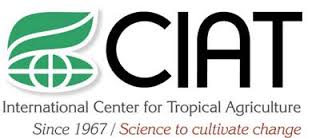Mission
To reduce hunger and poverty, and improve human nutrition in the tropics through research aimed at increasing the eco-efficiency of agriculture.
People
CIAT’s staff includes about 200 scientists. Supported by a wide array of donors, the Center collaborates with hundreds of partners to conduct high-quality research and translate the results into development impact. A Board of Trustees provides oversight of CIAT’s research and financial management.
Values
- Shared organizational ethic
- We respect each other, our partners, and the people who benefit from our work. We act with honesty, integrity, transparency, and environmental responsibility in all of our joint endeavors.
- Learning through partnerships
- We work efficiently and pragmatically together and with partners. Considering our diversity to be a key asset, we adapt readily to change and strive to improve our performance through continuous learning.
- Innovation for impact
- We develop innovative solutions to important challenges in tropical agriculture, resulting in major benefits for the people who support, participate in, and profit from our work.
Members:
Resources
Displaying 891 - 895 of 958White mold
White mold, caused by the fungus Sclerotinia (Whetzelinia) sclerotiorum, is distributed worldwide and has more than 300 hosts. It infects flowers, cotyledons, seeds, leaves or injured plant tissue. The disease can be controlled by crop rotation, flooding, reduced seeding rates, application of chemical products in the middle of the flowering period, modifying plant architecture and the use of resistant var. Many soil microorganisms are associated with sclerotia and may cause them to degrade or fan to germinate. The symptoms and damage caused by the disease are illustrated in color.
Transference of technology
En ensayos de campo efectuados en 1977-79 en CIAT-Quilichao, se establecieron al finalizar 1977, a) 5 especies de gramineas altas y espesas, b) 6 especies de gramineas estolonifgeras semi-erectas, c) 6 especies de gramineas de escasa doiseminacion, d) 6 especies de leguminosas rastreras, e) 6 especies de leguminosas arbustivas y f) 6 especies de leguminosas forrajeras; se aplico 0 o 100 kg de N + 44 kg de P2O5 + 100Kg de cal o 200 kg de N + 88 kg de P2O5 +41 kg de K2O + 2t de cal/ha.
International cooperation
The progress achieved by CIAT's cassava program through training activities related to the crop in Latin America, Asia, and Oceania are given. In collaboration with the training office at the Centro Internacional de Agricultura Tropical, the cassava program in 1980 trained 38 professionals from 15 countries (Brazil, Colombia, Mexico, Bolivia, USA, Thailand, Dominican Republic, S. Africa, Ecuador, Haiti, Honduras, W. Germany, the Netherlands, Great Britain, and Italy).
Cooperación internacional
The progress achieved by CIAT's cassava program through training activities related to the crop in Latin America, Asia, and Oceania are given. In collaboration with the training office at the Centro Internacional de Agricultura Tropical, the cassava program in 1980 trained 38 professionals from 15 countries (Brazil, Colombia, Mexico, Bolivia, USA, Thailand, Dominican Republic, S. Africa, Ecuador, Haiti, Honduras, W. Germany, the Netherlands, Great Britain, and Italy).
Desordenes nutricionales
Different nutritional deficiencies or toxicities may limit bean development and yield. N and P deficiencies are the most frequent, although deficiency of minor elements and Al/Mn toxicity can reduce yields considerably. Nutritional problems are usually diagnosed by soil and plant tissue analyses and the observation of symptoms produced by nutritional disorders. Optimum pH for bean production varies between 6.5-7.5; within these limits, the majority of the plant nutrients have their max availability. Color illustrations are given of the symptoms of plant deficiencies and toxicities.


